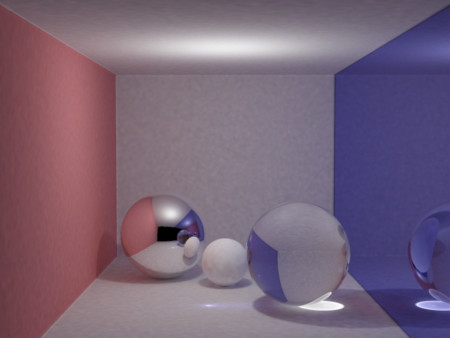#include <math.h>
#include <stdlib.h>
#include <stdio.h>
#include <vector>
const double PI=3.14159265358979; int estimate=10;
int primes[61]={2,3,5,7,11,13,17,19,23,29,31,37,41,43,47,53,59,61,67,71,73,79,
83,89,97,101,103,107,109,113,127,131,137,139,149,151,157,163,167,173,179,181,
191,193,197,199,211,223,227,229,233,239,241,251,257,263,269,271,277,281,283};
inline int rev(const int i,const int p) {if (i==0) return i; else return p-i;}
double hal(const int b, int j) {
const int p = primes[b]; double h = 0.0, f = 1.0 / (double)p, fct = f;
while (j > 0) {h += rev(j % p, p) * fct; j /= p; fct *= f;} return h;}
struct Vec {double x, y, z;
Vec(double x_ = 0, double y_ = 0, double z_ = 0) {x = x_; y = y_; z = z_;}
inline Vec operator+(const Vec &b) const {return Vec(x+b.x, y+b.y, z+b.z);}
inline Vec operator-(const Vec &b) const {return Vec(x-b.x, y-b.y, z-b.z);}
inline Vec operator*(double b) const {return Vec(x * b, y * b, z * b);}
inline Vec mul(const Vec &b) const {return Vec(x * b.x, y * b.y , z * b.z);}
inline double sqlen() const {return dot(*this);}
inline Vec norm() const {return (*this) * (1.0 / sqrt(sqlen()));}
inline double dot(const Vec &b) const {return x * b.x + y * b.y + z * b.z;}
Vec operator%(Vec&b) {return Vec(y*b.z-z*b.y,z*b.x-x*b.z,x*b.y-y*b.x);}};
struct Ray {Vec o, d; Ray(){}; Ray(Vec o_, Vec d_) : o(o_), d(d_) {}};
enum Refl_t {DIFF, SPEC, REFR};
struct Sphere {double rad; Vec p, c; Refl_t refl;
Sphere(double r_,Vec p_,Vec c_,Refl_t re_) : rad(r_),p(p_),c(c_),refl(re_){}
inline double intersect(const Ray &r) const {
Vec op=p-r.o; double t, b=op.dot(r.d), det=b*b-op.dot(op)+rad*rad;
if (det < 0) return 1e20; else det = sqrt(det);
return (t=b-det) > 1e-4 ? t : ((t=b+det)>1e-4 ? t : 1e20);}};
const Vec LightPos(50,60,85), LightPow(PI*10000,PI*10000,PI*10000);
const Sphere sph[] = {
Sphere(1e5, Vec( 1e5+1,40.8,81.6), Vec(.75,.25,.25),DIFF),
Sphere(1e5, Vec(-1e5+99,40.8,81.6),Vec(.25,.25,.75),SPEC),
Sphere(1e5, Vec(50,40.8, 1e5), Vec(.75,.75,.75),DIFF),
Sphere(1e5, Vec(50,40.8,-1e5+170), Vec(), DIFF),
Sphere(1e5, Vec(50, 1e5, 81.6), Vec(.75,.75,.75),DIFF),
Sphere(1e5, Vec(50,-1e5+81.6,81.6),Vec(.75,.75,.75),DIFF),
Sphere(16.5,Vec(27,16.5,47), Vec(1,1,1)*.999, SPEC),
Sphere(16.5,Vec(73,16.5,88), Vec(1,1,1)*.999, REFR),
Sphere(8.5, Vec(50,8.5,60), Vec(1,1,1)*.999, DIFF)};
int toInt(double x){return int(pow(1-exp(-x),1/2.2)*255+.5);}
inline bool intersect(const Ray &r,double &t,int &id){
int n = sizeof(sph) / sizeof(Sphere); double d, inf = 1e20; t = inf;
for(int i=0;i<n;++i){d=sph[i].intersect(r);if(d<t){t=d;id=i;}}return t<inf;}
void genp(Ray* pr, Vec* f, int i) { *f = LightPow;
double p=2*PI*hal(0,i), t=2*acos(sqrt(1.-hal(1,i))), st=sin(t);
pr->d=Vec(cos(p)*st, cos(t), sin(p)*st); pr->o=LightPos; }
struct Photon { Vec x, fl; };
struct AABB { Vec l, u; AABB():l(1e20,1e20,1e20),u(-1e20,-1e20,-1e20){}
inline void fit(const Vec &p) {
l.x=std::min(p.x,l.x); l.y=std::min(p.y,l.y); l.z=std::min(p.z,l.z);
u.x=std::max(p.x,u.x); u.y=std::max(p.y,u.y); u.z=std::max(p.z,u.z);}};
inline int sepaxis(Photon** photons, unsigned n) { AABB aabb;
for (unsigned i=0; i<n; ++i) aabb.fit(photons[i]->x); Vec w=aabb.u-aabb.l;
return w.x>w.y?(w.x>w.z?0:(w.y>w.z?1:2)):(w.y>w.z?1:(w.x>w.z?0:2));}
inline int log_2(int x) {int n; for (n=0; x>1; x>>=1,++n); return n;}
inline int median(int n) {int h=log_2(n),s=1<<h,d=n-s,s2=s/2;
if (s2>0 && d>=s2) d=s2-1; return s2+d;}
bool cmpx(const Photon* a,const Photon* b) {return a->x.x < b->x.x;}
bool cmpy(const Photon* a,const Photon* b) {return a->x.y < b->x.y;}
bool cmpz(const Photon* a,const Photon* b) {return a->x.z < b->x.z;}
struct KDTree { Photon** photons; char* nodes; unsigned total;
void build(Photon** buf,unsigned total_) {total=total_;
photons=new Photon*[total]; nodes=new char[total/2]; sep(buf,0,total);}
void nearest(Photon** buf,double* dist,int n,const Vec& x,double d2) {
for (int i=0; i<n; ++i) {buf[i]=NULL; dist[i]=d2;} trav(buf,dist,n,x,0);}
void sep(Photon** buf, unsigned i, unsigned n) {
if (n==1) photons[i]=*buf; else if (n>1) { int axis=sepaxis(buf, n);
std::sort(buf, buf+n, (axis==0)?cmpx:(axis==1)?cmpy:cmpz);
int m=median(n); photons[i]=buf[m]; nodes[i]=axis;
{ sep(buf,i*2+1,m); sep(buf+m+1,i*2+2,n-m-1); }}}
void trav(Photon** buf,double* dist,int n,const Vec& x,unsigned i) {
if (i>=total) return; else if (i*2+1<total) {
int axis=nodes[i]; Vec& v=photons[i]->x; double* pd2=&dist[n-1];
double e=(axis==0 ? x.x-v.x : (axis==1 ? x.y-v.y : x.z-v.z));
if(e<0){trav(buf,dist,n,x,i*2+1);if(e*e<*pd2)trav(buf,dist,n,x,i*2+2);}
else {trav(buf,dist,n,x,i*2+2);if(e*e<*pd2)trav(buf,dist,n,x,i*2+1);}}
double e2=(photons[i]->x-x).sqlen(); if (e2>=dist[n-1]) return;
int l,r,m; for (l=0,r=n;l<r;) {m=(l+r)/2; (e2<dist[m])?r=m:l=m+1;}
for (int j=n; --j>l; ) {buf[j]=buf[j-1]; dist[j]=dist[j-1];}
buf[l]=photons[i]; dist[l]=e2; } };
std::vector<Photon*> g_photons; KDTree g_kdtree;
Vec trace(const Ray &r, int dpt, bool m, const Vec &fl, int i) {
double t;int id,d3=++dpt*3; if((dpt>=20)||!intersect(r,t,id)) return Vec();
const Sphere&obj=sph[id]; const Vec x=r.o+r.d*t,n=(x-obj.p).norm(),&f=obj.c;
Vec nl=n.dot(r.d)<0?n:n*-1; if (obj.refl == DIFF) {
if (m) { Photon** b=(Photon**)alloca(sizeof(Photon*)*estimate);
double* rr=(double*)alloca(sizeof(double)*estimate);
g_kdtree.nearest(b,rr,estimate,x,1e20); Vec flux;const double fr=1.0/PI;
int j,k; for (j=k=0; j<estimate; k=j++) { Photon* q=b[j]; if (!q) break;
flux=flux+q->fl*fr; } return flux.mul(f)*(1.0/(PI*rr[k])); }
Photon* q=new Photon; q->x=x; q->fl=fl; double p=fmax(f.x,fmax(f.y,f.z));
#pragma omp critical
g_photons.push_back(q); if (hal(d3+1,i)>=p)return Vec();
double r1=2.*PI*hal(d3-1,i), r2=hal(d3+0,i), r2s=sqrt(r2);
Vec &w=nl, u=((fabs(w.x)>.1?Vec(0,1):Vec(1))%w).norm(), v=w%u;
Vec d = (u*cos(r1)*r2s + v*sin(r1)*r2s + w*sqrt(1-r2));
return trace(Ray(x,d),dpt,m,f.mul(fl)*(1./p),i);
} else if (obj.refl == SPEC) {
return trace(Ray(x,r.d-n*2*n.dot(r.d)),dpt,m,f.mul(fl),i).mul(f);
} else {Ray lr(x,r.d-n*2.0*n.dot(r.d)); bool into = (n.dot(nl)>0.0);
double nc = 1.0, nt=1.5, nnt = into?nc/nt:nt/nc, ddn = r.d.dot(nl), cos2t;
if ((cos2t=1-nnt*nnt*(1-ddn*ddn))<0) return trace(lr,dpt,m,fl,i);
Vec td = (r.d*nnt - n*((into?1:-1)*(ddn*nnt+sqrt(cos2t)))).norm();
double a=nt-nc, b=nt+nc, R0=a*a/(b*b), c = 1-(into?-ddn:td.dot(n));
double Re=R0+(1-R0)*c*c*c*c*c,P=Re;Ray rr(x,td);Vec rfl=f.mul(fl);
return m ? (trace(lr,dpt,m,fl,i)*Re + trace(rr,dpt,m,fl,i)*(1-Re)).mul(f)
: hal(d3-1,i)<P ?trace(lr,dpt,m,rfl,i) :trace(rr,dpt,m,rfl,i);}}
int main(int argc, char *argv[]) { int w=1024, h=768, samps=1, BKT=1000, n=0;
argc>1&&(samps=atoi(argv[1])/BKT); argc>2&&(estimate=atoi(argv[2]));
#pragma omp parallel for schedule(dynamic, 1)
for(int i=0; i<samps; ++i) { int m=BKT*i; Ray r; Vec f;
#pragma omp atomic
++n; fprintf(stderr,"\rPhotonPass %5.2f%%",100.*n/samps);
for(int j=0;j<BKT;++j) { genp(&r,&f,m+j); trace(r,0,false,f,m+j+1); }}
fprintf(stderr, "\n#photons:%zu\nBuilding kd-tree...\n", g_photons.size());
if (!g_photons.empty()) g_kdtree.build(&g_photons[0], g_photons.size());
Ray cam(Vec(50,52,295.6), Vec(0,-0.042612,-1).norm()); n=0;
Vec cx=Vec(w*.5135/h), cy=(cx%cam.d).norm()*.5135, *cc=new Vec[w*h];
#pragma omp parallel for schedule(dynamic, 1)
for (int y=0; y<h; ++y) {
#pragma omp atomic
++n; fprintf(stderr, "\rHitPointPass %5.2f%%", 100.0*n/h);
for (int x=0; x<w; ++x) { Vec r, dmy; const double s=1.0/(BKT*samps*2*2);
for (int v=0; v<2; ++v) for (int u=0; u<2; ++u) {
Vec d = cx * ((x+u*.5+.25)/w-.5) + cy * (-(y+v*.5+.25)/h+.5) + cam.d;
r=r+trace(Ray(cam.o+d*130,d.norm()),0,true,dmy,0);} cc[x+y*w]=r*s;}}
FILE* f = fopen("image_pm.ppm","w"); fprintf(f,"P3\n%d %d\n%d\n",w,h,255);
for (int i=0; i<w*h; ++i) { const Vec& c = cc[i];
fprintf(f,"%d %d %d ", toInt(c.x), toInt(c.y), toInt(c.z));}}
|
